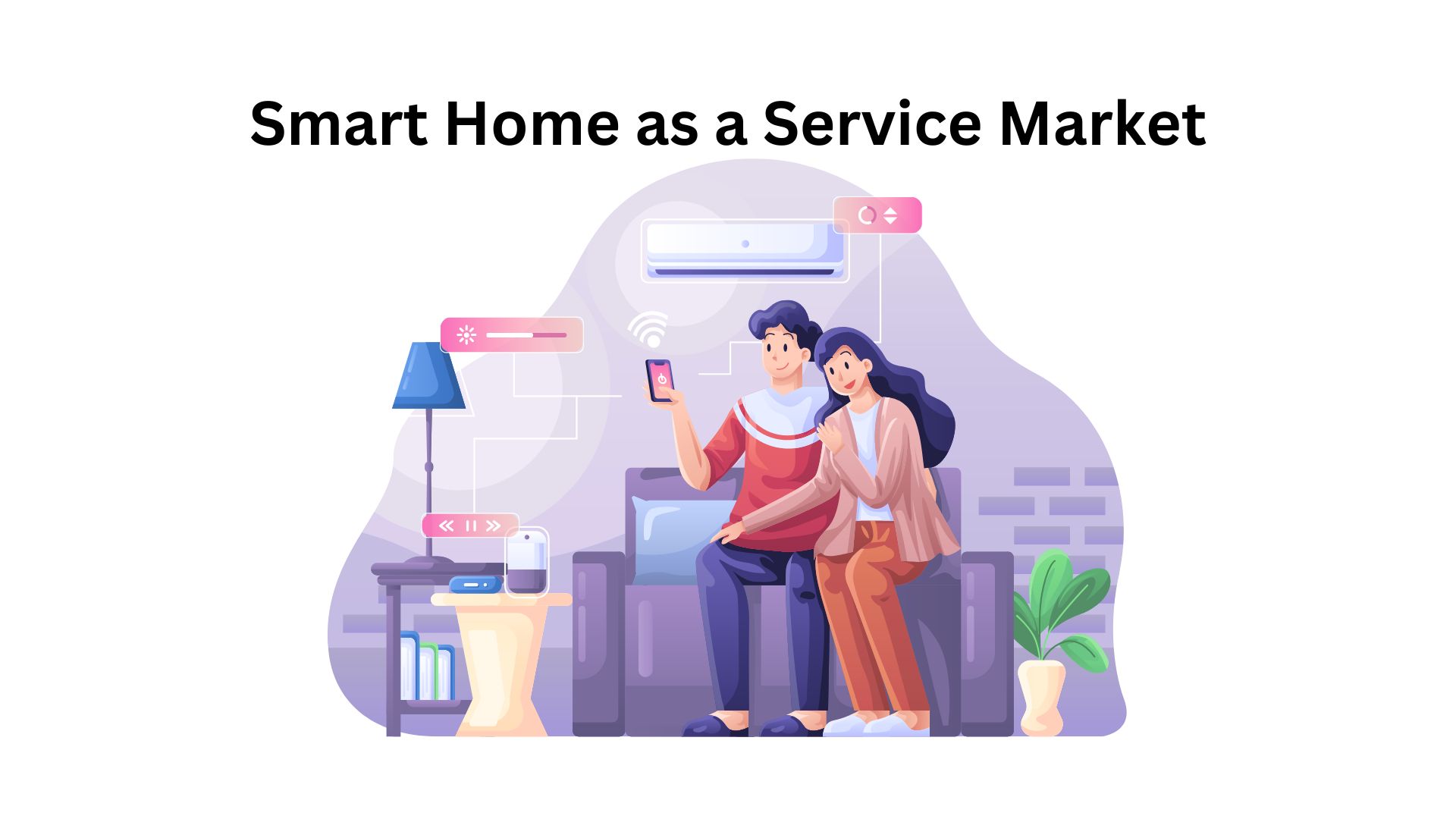Smart Home as a Service Market Vendors Analysis | Growth Rate 15.40% By 2032

Page Contents
Smart Home as a Service Market Overview
Published Via 11Press: Smart Home as a Service (SHaaS) is a subscription-based model in which customers pay an ongoing fee to access smart home products and services through a cloud-based platform. SHaaS allows customers to remotely control and monitor their connected devices from a unified interface, offering convenience, security, and energy savings benefits.
The global smart home as a service market is expected to experience rapid growth over the coming years, driven by increasing demand for connected devices and services, growing awareness of energy-saving solutions, and rising adoption of smart homes across both developed and developing countries.
The global smart home as a service market size is forecast to reach USD 27.23 billion by 2032 from USD 6.50 billion in 2022, rising at a compound annual growth rate (CAGR) of 15.40% during the forecast period.
The market is divided by service type, home type, and region. Managed services, integrated services, and consulting are some of the service types available while home types include apartments, villas, and independent homes. Regionally, North America, Europe, Asia-Pacific, Middle East & Africa as well as South America make up the regional segments.
Key players in the SHaaS market include Amazon.com Inc., Apple Inc., Alphabet Inc., Samsung Electronics Co., Ltd. and LG Electronics Inc. Other players operating within this space include Vivint Smart Home Inc., Honeywell International Inc., ADT Inc., Comcast Corporation and CenturyLink, Inc.
Factors driving the growth of this market include rising demands for convenience and security, advances in Internet of Things (IoT) technology, and government initiatives to promote energy-saving solutions. However, high installation and maintenance costs as well as concerns over data privacy and security may hinder market expansion.
Request For Sample Report: https://market.us/report/smart-home-as-a-service-market/request-sample/

Key Takeaways
- Smart Home as a Service (SHaaS) is an on-demand subscription model that enables customers to remotely control and monitor their smart home devices from one centralized interface, providing convenience, security, and energy savings.
- The global SHaaS market is projected to experience significant growth over the coming years, driven by increasing demand for connected devices and services, raising awareness of energy-saving solutions, and increasing adoption of smart homes across both developed and developing countries.
- The market is segmented by service type, home type, and region. Managed services, integrated services, and consulting are the leading types of offerings; home types range from apartments to villas and independent homes.
- Key players in the SHaaS market include Amazon.com Inc., Apple Inc., Alphabet Inc., Samsung Electronics Co., Ltd. and LG Electronics Inc.
- Factors fueling the growth of this market include an increasing desire for convenience and security, advances in Internet of Things (IoT) technology, and government initiatives to promote energy-saving solutions.
- However, the high cost of installation and upkeep, as well as concerns over data privacy and security may constrain market expansion.
Regional Snapshot
- North America will dominate the SHaaS market due to the widespread presence and high adoption of smart home products in this region.
- Europe is expected to witness significant growth on the SHaaS Market due to an increasing adoption of smart home technology and energy-saving measures across the region.
- The Asia-Pacific SHaaS market is expected to experience substantial growth due to rising urbanization and increasing disposable income levels in the region. India and China are anticipated to play major roles in driving market development within this region.
- The SHaaS market in Africa and Middle East is expected to experience rapid expansion due to increased adoption of smart home technology and heightened demand for energy-saving products in these regions.
- South America is projected to experience moderate growth in the SHaaS market due to an increasing adoption of smart home technology and demand for energy-saving options in the region. Brazil is expected to lead this expansion within South America.
Drivers
- Increased Demand for Convenience and Security: Smart home solutions provide users with convenience and security by allowing them to control and monitor their homes remotely through a unified interface. This has spurred the adoption of these solutions, thus fueling growth in the SHaaS market.
- Advances in Internet of Things (IoT) technology: IoT technology continues to advance, enabling more devices to be connected to the internet and giving users greater control and automation over their homes. This has resulted in the exponential growth of the SHaaS market as more individuals seek to take advantage of IoT benefits at home.
- Government initiatives to encourage energy-saving solutions: Governments around the world are taking steps to promote energy conservation in homes. This has spurred the adoption of smart home solutions, which can help individuals reduce their energy usage and carbon footprint.
- Rise in Adoption of Smart Homes: As more consumers become aware of the advantages associated with smart home solutions and connected devices become more accessible, demand for subscription-based service models to access these solutions is on the rise. This trend is fueling growth within the SHaaS market as more users look to access these systems through subscription-based subscription models.
Restraints
- High Cost of Installation and Upkeep: Installing and maintaining smart home solutions can be costly, which could be a deterrent to adoption for some users, particularly those looking to retrofit their homes with these technology-enabled amenities.
- Concerns Over Data Privacy and Security: Smart home solutions are vulnerable to cyberattacks that could compromise users' data and privacy. This may be a deterrent for some who worry about the safety of their personal information.
- Lack of Interoperability: Smart home devices from different manufacturers often utilize different communication protocols, making integration into one system difficult. This may pose a barrier to adoption for some users who desire a unified smart home experience.
- Limited Awareness and Understanding: Despite the growing adoption of smart homes, many users still lack a comprehensive awareness and comprehension of their benefits and capabilities. This can be an impediment to adoption for those unfamiliar with the technology.
Opportunities
- Subscription-Based Model Adoption on the Rise: Subscription models are becoming increasingly popular, particularly among younger consumers. This presents an opportunity for the SHaaS market as more users look to access smart home solutions through subscription-based service models.
- Demand for energy-efficient solutions: Energy efficiency has become a top priority for many consumers due to factors like rising energy costs and concerns about climate change. This presents an opportunity for the SHaaS market, as smart home solutions can help users reduce their energy consumption and carbon footprint.
- Integration with Other Smart Systems: Smart home solutions can be integrated with other connected ecosystems, such as smart cities and grids, to form a more comprehensive and interconnected system. This presents the SHaaS market with an opportunity to move beyond the home and become part of larger smart infrastructures.
- Advances in artificial intelligence (AI) and machine learning (ML): As AI and ML become more advanced, smart home systems are able to learn from users' behaviors and preferences. This presents an opportunity for the SHaaS market to offer more tailored, intuitive smart home solutions.
Challenges
- Fragmented Market: The smart home market is highly fragmented, with many players offering a variety of products and services. This makes it difficult for users to navigate the space and locate suitable solutions tailored to their requirements.
- Lack of Industry Standards: The absence of industry standards for smart home devices and systems makes it challenging for users to integrate different devices into a single system, as well as for service providers to offer interoperable solutions.
- Limited Interoperability: Even when devices use the same communication protocols, interoperability can be limited due to the varying capabilities and functions of different products. This makes it challenging to provide users with a seamless smart home experience.
- Security Concerns: Smart home solutions can be vulnerable to cyberattacks, which could compromise users' data and privacy. For some individuals who worry about the security of their personal information, this may be a deterrent towards adoption.
- Cost: The cost of smart home solutions can be a deterrent for some users, especially those seeking to retrofit their homes with connected devices.
Grow your profit margin with Market.us Get this Report
Recent Developments
- Partnership Between Amazon and Lennar: In 2021, Amazon announced a collaboration with Lennar, one of the nation's largest home builders, to offer smart home packages as part of new home construction. These packages include Alexa voice assistant, smart thermostats, doorbells, and security cameras from Amazon.
- Acquisition of ADT by Google: In early 2021, Google announced its intention to acquire ADT, a provider of security and smart home solutions. The acquisition is expected to enable them to expand their current smart home offerings while integrating them with ADT's security solutions.
- Apple's HomePod Mini: In 2020, Apple unveiled their HomePod mini smart speaker featuring Siri voice assistant and the ability to control other smart home devices. This model competes with other high-end smart speakers like Amazon's Echo and Google's Nest.
- Expansion of Comcast's Xfinity Home: Comcast has recently expanded its Xfinity Home smart home solution, providing a range of services such as security, home automation, and energy management. This service is designed to integrate with other Xfinity products like cable TV and internet access.
- Subscription-Based Models Are Becoming More Popular: Subscription models are becoming increasingly popular in the smart home market, with companies such as Vivint and SimpliSafe offering subscription-based smart home services. This trend is expected to continue as more users seek convenience and flexibility with subscription-based offerings.
Key Market Segments
Type
- Managed Services
- Integrated Services
Application
- Security and Access
- Lighting and Window
- Audio-Visual and Entertainment
- Energy Management and Climate
Key Market Players
- AT&T
- CenturyLink
- Johnson Controls
- The ADT Corporation
- Vivint Inc.
- Charter Communications (TWC)
- Comcast Corporation
- Frontpoint Security Solutions
- Ingersoll-Rand plc (Nexia)
- Protection One Alarm Monitoring Inc
Nature Insights
The Smart Home as a Service (SHaaS) market is rapidly growing within the broader smart home industry. SHaaS models offer solutions and services on a subscription basis, enabling users to take advantage of various smart home features without needing to invest in costly hardware or software components.
One distinguishing characteristic of the SHaaS market is its focus on offering users an intuitive and seamless smart home experience. This is achieved through cloud-based platforms that integrate different smart home devices and services into one unified system. Users are then able to control their devices through one app or voice assistant, creating a more convenient and streamlined user journey.
Another key characteristic of the SHaaS market is its emphasis on data and analytics. SHaaS providers collect user information, which can be utilized to optimize device and service performance as well as generate personalized recommendations and enhance the overall smart home experience.
The SHaaS market is highly competitive, with an abundance of players offering various services and solutions. To be successful in this space, companies must offer differentiated products and services that add real value to users while also providing reliable and secure platforms that protect users' data and privacy.
Report Scope
| Report Attribute | Details |
| The market size value in 2022 | USD 6.50 Bn |
| Revenue forecast by 2032 | USD 27.23 Bn |
| Growth Rate | CAGR Of 14.40% |
| Regions Covered | North America, Europe, Asia Pacific, Latin America, and Middle East & Africa, and the Rest of the World |
| Historical Years | 2017-2022 |
| Base Year | 2022 |
| Estimated Year | 2023 |
| Short-Term Projection Year | 2028 |
| Long-Term Projected Year | 2032 |
Frequently Asked Questions
Q: What is Smart Home as a Service (SHaaS)?
SHaaS, also known as Smart Home as a Service, is an annual subscription-based model that gives users access to smart home devices and services without needing to invest in costly hardware or software. SHaaS providers provide cloud-based platforms which enable different smart home components and services to be integrated into one centralized system.
Q: What are the advantages of SHaaS?
A: SHaaS offers several advantages, such as lower upfront costs, access to more smart home devices and services, and the convenience of using one app or voice assistant for all control. Plus, SHaas allows users the freedom to add or remove devices and services as needed.
Q: Who are some popular SHaaS providers?
Popular options include Vivint, SimpliSafe, ADT, Comcast Xfinity Home, and Amazon Smart Home Services.
Q: What types of devices and services are typically provided by SHaaS providers?
A: SHaaS providers offer an extensive selection of products and services, such as security systems, smart thermostats, lighting control, locks with biometric authentication systems, home automation systems, and energy management solutions.
Q: What challenges face the SHaaS market?
A: Some of the issues confronting this space include fragmentation, lack of industry standards, limited interoperability, security concerns, and cost concerns.
Q: What is the future of the SHaaS market?
A: The SHaaS market is expected to experience continued growth as more users embrace smart home solutions. Drivers in this space include subscription-based models, seamless integration between devices and services, as well as data analytics for optimizing user experiences.
The team behind market.us, marketresearch.biz, market.biz and more. Our purpose is to keep our customers ahead of the game with regard to the markets. They may fluctuate up or down, but we will help you to stay ahead of the curve in these market fluctuations. Our consistent growth and ability to deliver in-depth analyses and market insight has engaged genuine market players. They have faith in us to offer the data and information they require to make balanced and decisive marketing decisions.



